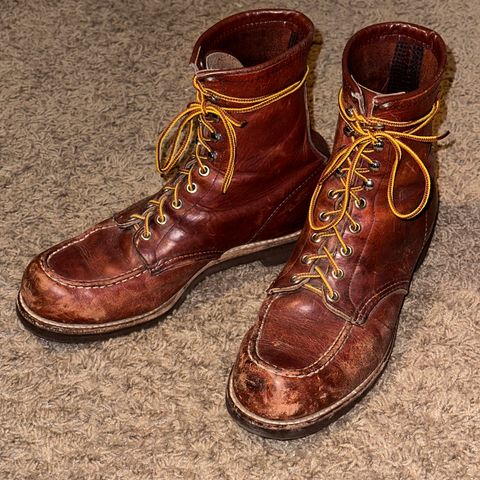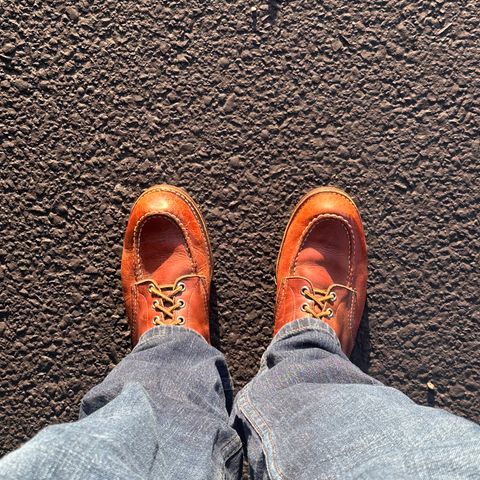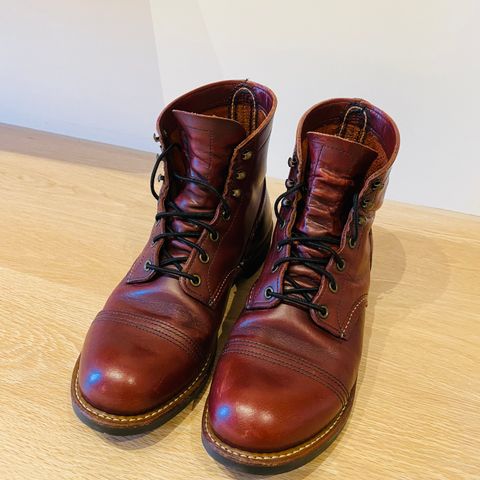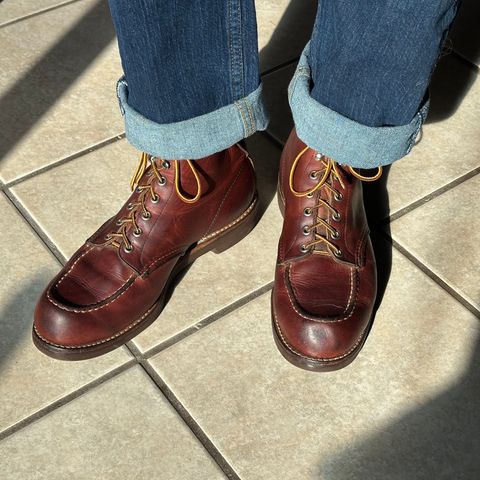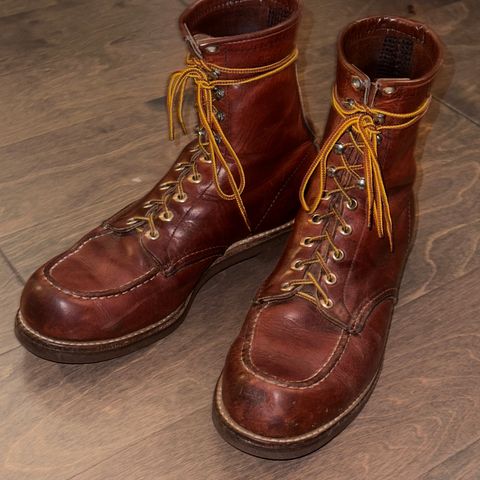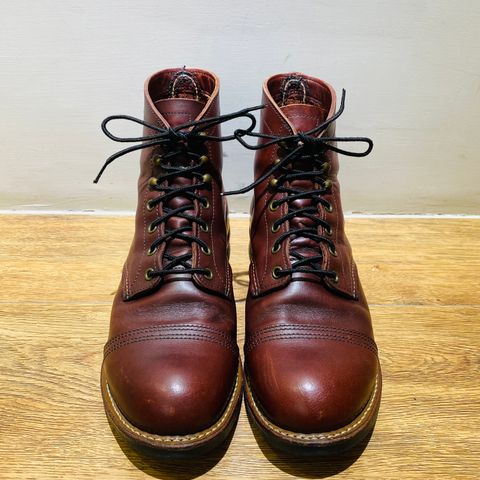About
S.B. Foot Oxblood Mesa is a color variation of Mesa oil-tanned leather produced by S.B. Foot Tanning Company in Red Wing, Minnesota. The leather features reddish-brown tones characteristic of oxblood colorways, achieved through specialized dyes applied during the tannery's traditional wooden drum processing. Oxblood Mesa combines the technical properties of Mesa leather—including chrome-tanned base, oil and wax conditioning, and water resistance—with a distinctive darker coloration that develops rich patina through wear.
About
S.B. Foot Oxblood Mesa is a color variation of Mesa oil-tanned leather produced by S.B. Foot Tanning Company in Red Wing, Minnesota. The leather features reddish-brown tones characteristic of oxblood colorways, achieved through specialized dyes applied during the tannery's traditional wooden drum processing. Oxblood Mesa combines the technical properties of Mesa leather—including chrome-tanned base, oil and wax conditioning, and water resistance—with a distinctive darker coloration that develops rich patina through wear.
The Oxblood variation appears in multiple Red Wing Heritage boot models, including the 8119 Iron Ranger and 8856 Classic Moc Toe, where the leather's aging characteristics and weather resistance support both aesthetic and functional requirements. The color exhibits depth from oil-tanning penetration, with natural marks and wear patterns becoming more pronounced over time as the leather develops individualized character.
Color characteristics
Oxblood Mesa displays reddish-brown tones that fall within the traditional oxblood color spectrum. The coloration results from specialized dyes added to the oak wooden drums during S.B. Foot's 14 to 20-hour barrel processing, where tree oils, tanning agents, and colorants penetrate deep into the leather fibers. The longer drum rotation time allows dyes to fully saturate throughout the leather thickness, creating color depth that extends beyond surface application.
The oil-tanning process contributes to the color's richness, as the high oil content interacts with the dye molecules to produce tonal complexity. This depth becomes more apparent through wear, with flexed and creased areas showing subtle color variation as the leather's pull-up characteristics reveal lighter undertones beneath the surface. The chrome-tanned base provides stability for the colorant, preventing excessive fading while allowing natural patina development.
Natural marks present in the steerhide remain visible in Oxblood Mesa, appearing as darker or lighter spots depending on how the dye interacts with different hide textures. These variations integrate into the overall appearance rather than detracting from it, contributing to the leather's characteristic look. Color consistency within production batches follows S.B. Foot's standard grading practices, with acceptable tonal variation typical of natural leather processing.
Physical properties
Oxblood Mesa retains all physical characteristics of the Mesa leather type, including chrome-tanned base structure, oil and wax conditioning, and semi-aniline finish. The leather exhibits a smooth surface with slightly waxy hand feel, resulting from the oil and wax blend applied during drum processing. The finish provides water, stain, and perspiration resistance while maintaining sufficient breathability for footwear applications.
The leather shows modest pull-up effects where bent or stretched, with the oxblood color lightening in flexed areas to reveal warmer undertones. This pull-up behavior proves less dramatic than some oil-tanned leathers but remains visible enough to add visual interest during wear. The matte finish characteristic of Mesa leather persists across the Oxblood variation, providing consistent appearance without high gloss or excessive sheen.
Weight specifications for Oxblood Mesa match standard Mesa production at 5 to 6 ounces (2.0 to 2.4 millimeters), with medium temper suitable for boot upper construction. The chrome-tanned base provides dimensional stability and flexibility, while oil and wax conditioning creates characteristic feel and weather resistance. Initial color transfer may occur as surface oils stabilize during the first weeks of wear, a common trait of oil-tanned leathers with high oil content.
Applications
Oxblood Mesa finds primary application in heritage footwear, particularly Red Wing Heritage boot models where the combination of traditional aesthetics and technical performance align with brand identity. The leather appears in the 8119 Iron Ranger, a six-inch service boot with cap toe construction, where Oxblood Mesa provides the durability and weather resistance appropriate for the model's work boot heritage. The 8856 Classic Moc Toe also features Oxblood Mesa, pairing the leather with white Cushion Crepe Wedge outsole for contrast between dark upper and light sole.
The 5-6 ounce weight provides sufficient structure for boot uppers while maintaining flexibility necessary for comfortable break-in. The leather's water and stain resistance supports outdoor use and work environments where exposure to moisture occurs regularly. The semi-aniline finish accepts limited surface treatment but maintains enough natural character to develop distinctive patina patterns.
Beyond footwear, Oxblood Mesa's characteristics suit leather goods applications where medium-weight material with weather resistance proves advantageous. The color depth and aging properties appeal to makers and users who value patina development and natural material evolution. The higher oil content and waxy feel may limit applications requiring heavy tooling or detailed stamping, as the finish characteristics differ from vegetable-tanned leathers optimized for such work.
Aging and patina development
Oxblood Mesa develops patina through natural wear and environmental exposure, with the oil-tanned structure supporting aging without requiring heavy conditioning. The reddish-brown base color evolves as high-flex areas—including vamp creases, ankle bends, and toe caps—show increased pull-up effects and tonal variation. Natural marks present in the original hide become more visible and integrate into the overall aged appearance, creating individualized character unique to each pair of boots.
The leather ages through mechanical action and oxidation rather than conditioning product application. Flexing and creasing during wear compress and stretch leather fibers, revealing color variations and creating the distinctive patina associated with oil-tanned leather. Environmental factors including sunlight exposure and moisture contact contribute additional aging effects, with UV exposure potentially lightening high-exposure areas while protected sections maintain deeper oxblood tones.
All natural marks and imperfections that exist in the leather from production remain visible and become emphasized through aging. Small scars, brands, or scratches characteristic of second-run grade leather develop their own patina, often appearing lighter or darker than surrounding leather depending on how the marked tissue accepts oils and wear. This natural variation contributes to Oxblood Mesa's appeal among heritage footwear enthusiasts who value authentic material character over uniform appearance.
The minimal conditioning requirements support patina development, as avoiding over-application of oils and conditioners allows the leather's inherent characteristics to dictate aging patterns. Light cleaning with damp cloth maintains appearance without interfering with natural evolution, while occasional light conditioning with leather cream preserves suppleness without masking wear patterns or altering color significantly.
Care and maintenance
Oxblood Mesa requires minimal conditioning due to the high oil content established during manufacturing. The leather retains significant oils from the tannery's wooden drum processing, reducing the need for frequent product application. Light cleaning with damp cloth removes surface dirt and salt accumulation without stripping the leather's natural oils or affecting the finish.
For conditioning, leather cream represents the preferred product type, as it nourishes the leather without substantially altering the oxblood color or masking natural patina development. Application should remain light and infrequent, with conditioning necessary only when the leather shows signs of excessive dryness—typically manifesting as loss of suppleness or surface cracking. Heavier oils and mink oil-based conditioners may darken Oxblood Mesa significantly and reduce the leather's ability to develop characteristic wear patterns.
Initial color transfer during the first several weeks of wear requires no intervention, as this crocking diminishes naturally as surface oils stabilize. The phenomenon proves normal for oil-tanned leathers and does not indicate a defect or require treatment. Avoiding contact with light-colored clothing or furniture during this period prevents unwanted color transfer.
Water exposure should be addressed by allowing the leather to air dry at room temperature, as the chrome-tanned base and oil conditioning provide inherent water resistance. Forced drying through heat application or stuffing boots tightly with newspaper may affect leather temper and finish characteristics. Salt exposure from winter conditions requires prompt removal with damp cloth to prevent staining, though Oxblood Mesa's oil content provides some protection against salt damage.
Over-conditioning proves counterproductive, as excess product buildup can interfere with natural patina evolution and alter the leather's characteristic matte finish and moderate pull-up behavior. The goal of maintenance for Oxblood Mesa centers on preservation of the leather's inherent qualities rather than transformation through product application, allowing the material to age naturally while maintaining structural integrity.
References
"8119 Iron Ranger Oxblood Mesa". Red Wing Heritage. Retrieved October 14, 2025.
"8856 6'' Classic Moc Toe Oxblood Mesa". Red Wing Amsterdam. Retrieved October 14, 2025.
"Mesa - Red Oak". Maverick Leather Company. Retrieved October 14, 2025.
"SB Foot Oil Tan". The Leather Guy. Retrieved October 14, 2025.
